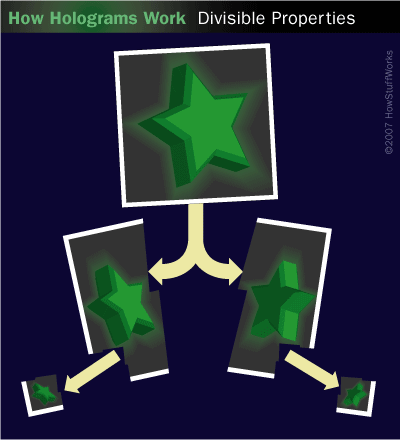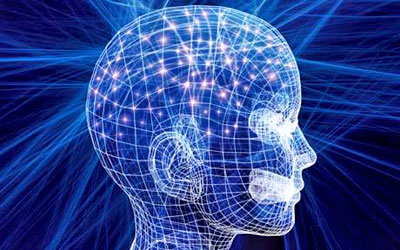A Play on Reality (Part 2 of 5: The holographic brain)
To better understand the origin of the holographic paradigm, it is important to understand holography. Holography functions based on the principles of interference, the crisscrossing pattern that happens when two or more waves pass through each other, without being altered, creating a multiplex pattern of interference between their crests and troughs (Serway vuille, 2009). A laser beam, one of the more coherent forms of light, is used in holography due to its excellent skill at creating these interference patterns. In the process of creating a hologram, the laser beam passes through a beam splitter creating two separate beams. The first beam bounces off of an object to be photographed while the second beam collides with the light reflected off of the object from the first beam, creating an interference pattern which is lastly projected onto a piece of film. Afterward, another source of light is shone through the film and this is what creates the 3-dimensional figure we see as a hologram (Holocenter, 2017).

An important characteristic of holography shows when you cut a piece of the film that previously depicted the object, in half. After illuminating the film once more, each half will still contain the entire image of the object. The whole image will continue to remain no matter how many times the film is divided, only the image will begin to fade slightly the more times the film is divided (Holography, 2017). Therefore, every fragment of a holographic film contains all of the information recorded as a whole.

A common form of matter that this paradigm relates to on both surface and complex levels is the brain itself. A former professor of psychology and psychiatry at several universities in the United States named Karl Pribram set the ground for relating the human brain to holography, though not his initial intentions, through experimentation with the help of several other well-founded scientists. The first question that sent Pribram on his journey: how and where are memories stored in the brain? It was generally believed that memories were localized, they had to have a specific location in the brain. This was believed due to an experiment by neurosurgeon, Wilder Penfield, who electrically stimulated a patient's brain cells in specific areas and found that in certain areas, mainly within the temporal lobe, the patient seemed to actually be reliving a specific memory in vivid detail and once restimulating the same area, would relive the exact same memory. This experiment lead Penfield to the conclusion that every experience that we have ever lived through is recorded in the brain.
This lead Pribram and neuropsychologist, Karl Lashley, to explore this conclusion in greater depths through an experiment performed by Lashley himself. In attempts to find the localized area for memory, he trained lab rats to perform several different obstacles and then proceeded to surgically remove the portions of their brains that were thought to contain memory. He continuously cut out portions until he had removed nearly 98% of their brains and still could not completely eliminate their memory, only their physical ability seemed to be impaired causing them to stumble and move slowly. This lead Pribram to the realization that memory is not localized, but distributed throughout the whole brain (Talbot, 2011).
If this is the case, however, what is the cause of memory loss? If it is not a certain area of the brain that is damaged, then how can the entire brain be affected in terms of memory loss, without having the potential to destroy the many other connections and abilities that the brain provides? The main cause of memory loss happens as we age. This is because as we age we have trouble “registering” new events and experiences in our nervous system, and due to slower processing, this dulls the accuracy, strength, and sharpness that we perceive with and as a result, creates a disruption in memory (doidge, 2008).
So if memory becomes impaired as our learning ability declines, where does the ability to learn to take place in the brain? The answer to this is almost all over. There is not one specific spot that controls how and what we learn. The neurons in our brains consist a brain fiber called dendrites and as we learn new material, these fibers grow and connect our brain cells to one another (USAtoday college, 2011). A shortly summed conclusion to this, stated by psychiatrist/psychoanalyst, Norman Doidge, “Our brain doesn’t simply learn, it is always learning how to learn.” (doidge, 2008)....
citations:
5 things you should know about how your brain learns. (2015, June 19). Retrieved May 04, 2017, from
http://college.usatoday.com/2015/06/19/5-way-your-brain-learns/.
College physics: vuille and serway. (2009). Pacific Grove, CA: Brooks/cole.
Doidge, N. (2008). The brain that changes itself: stories of personal triumph from the frontiers of brain science. Carlton North, Vic.: Scribe Publications.
Memory Storage. (n.d.). Retrieved May 06, 2017, from http://www.human-memory.net/
Talbot, M., & McTaggart, L. (2011). The holographic universe: the revolutionary theory of reality. New York, NY: HarperPerennial.
What is Holography? | holocenter. (n.d.). Retrieved May 16, 2017, from http://holocenter.org/what-is-holography
Holography. (n.d.). Retrieved May 16, 2017, from http://hyperphysics.phy-astr.gsu.edu/hbase/optmod/holog.html#c2
Each piece contains the whole